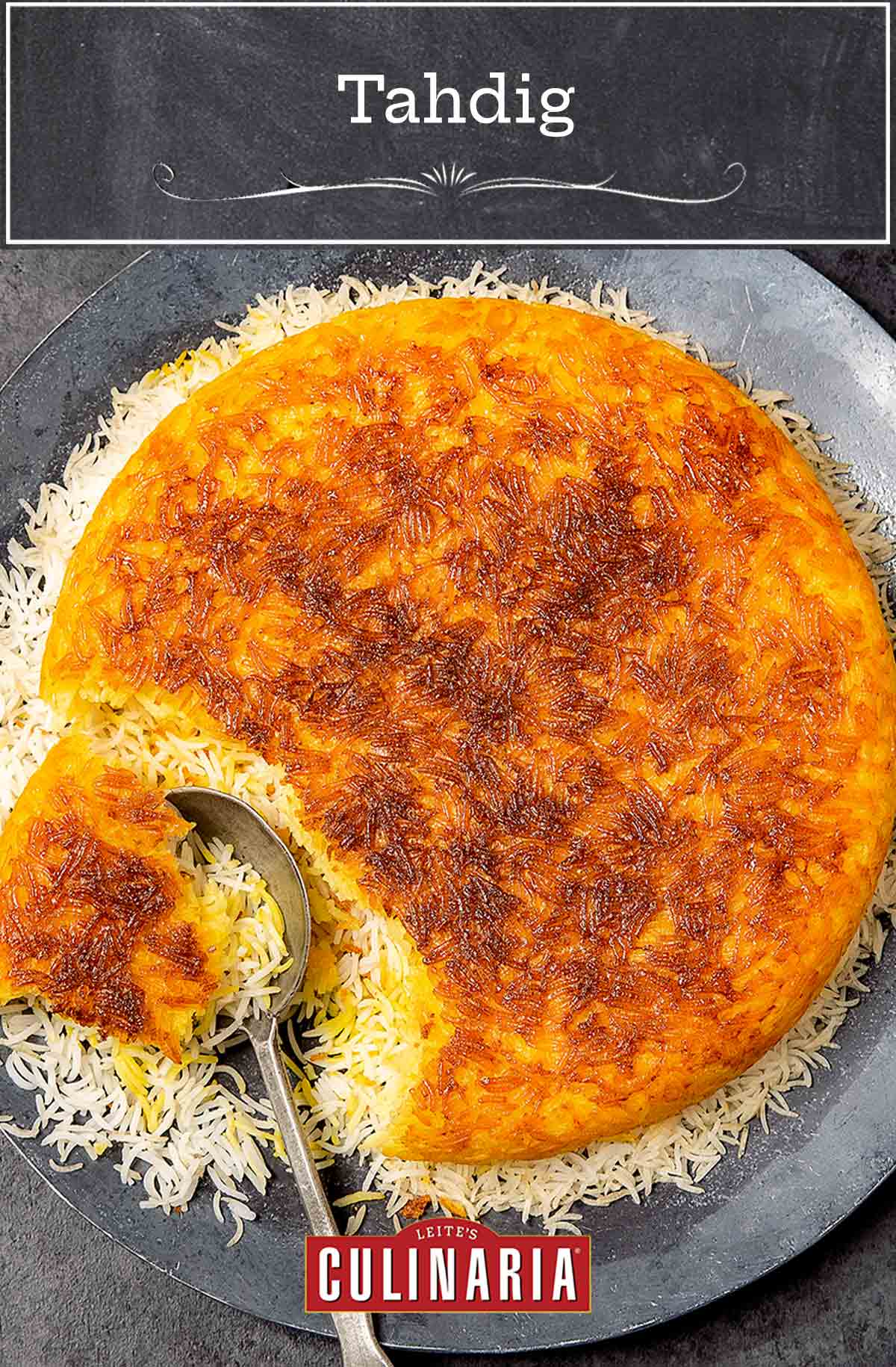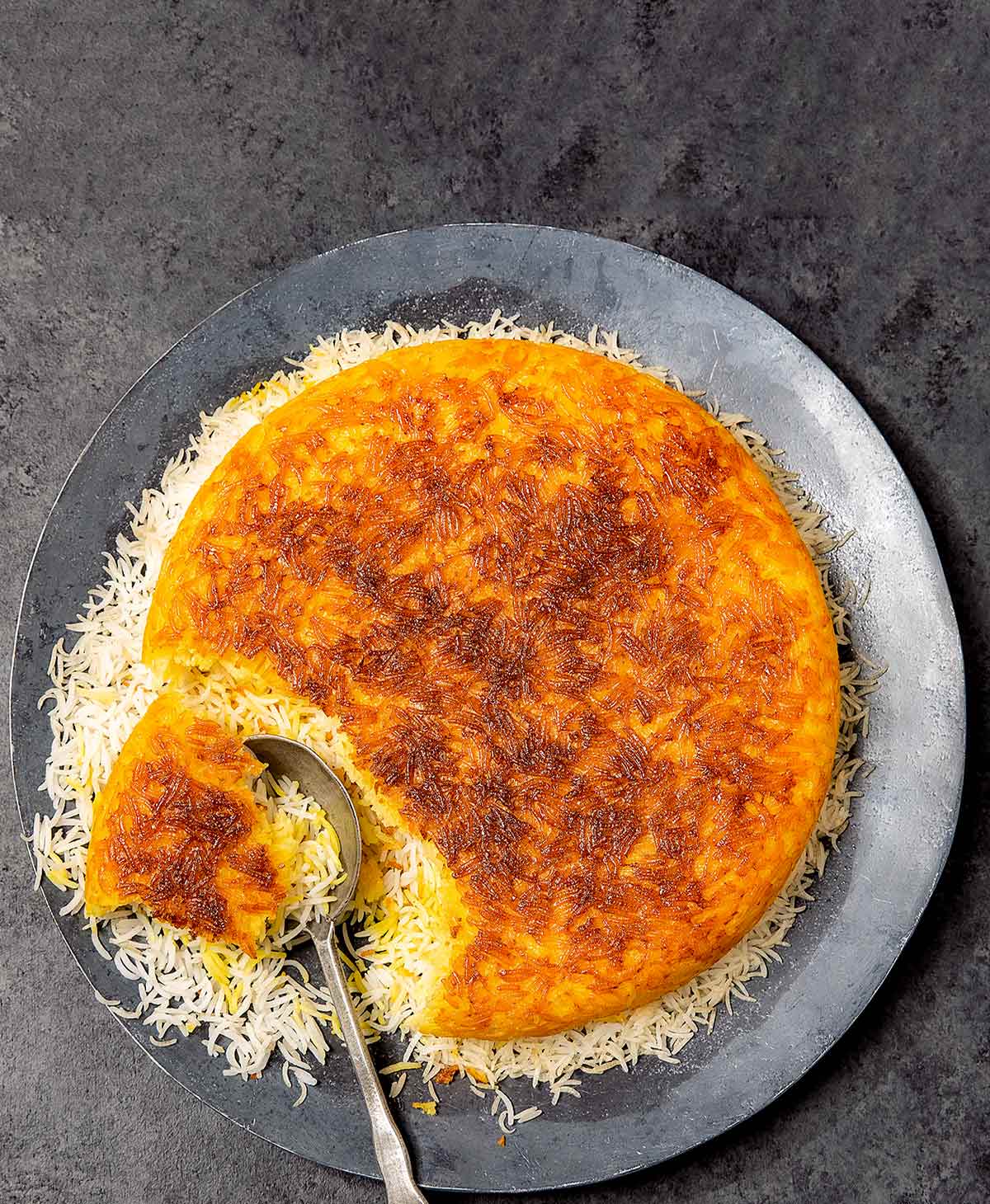
Jump To
In almost every food culture, there’s an obsession with the “crispy bits.” Whether it’s the crunchy pieces of pasta at the corners of lasagna or the coveted edge pieces clinging to the side of the brownie pan, we’d fight friends and family to the death for these prized morsels. Perched on this pedestal in Persian cuisine, tahdig may be the best crispy bit of them all. Literally translating to “bottom of the pot,” it’s the crispy layer that forms when rice is cooked low and slow. When you invert the pot onto a platter to serve, a mound of fluffy saffron rice is crowned with the golden, crisp tahdig, holding everything together until you break it open like a piñata. It’s just what you need to soak up any Persian stew or kebab. I don’t know of a better rice dish!
A few months into dating my husband, I arrived home to find a package from his mother. It contained two gifts that—as I’ve since discovered—every Persian mother sends to her child’s significant other: a Persian rice cooker and a copy of Food of Life, the Iranian cooking bible by Najmieh Batmanglij. The package was a not-so-subtle signal: learn how to make Alex’s favorite Persian dishes or else she would start shipping frozen Tupperwares of stews to keep him well-fed. I didn’t need much convincing, since, much as I had with Alex, I fell head over heels in love with Persian cuisine, and especially with tahdig.
The inclusion of yogurt—a trick borrowed from tahchin, a heavenly baked Persian rice casserole often stuffed with chicken—helps the crust stay together and cook evenly. And while not every family uses yogurt in their tahdig, I find it makes the dish so much more luxurious! That yogurt-coated mixture lines her rice cooker before getting topped with the remaining rice and a lot more saffron water and oil. With the press of a button, the rice cooker goes to work, spitting out a perfectly golden tahdig every time.
Call me a glutton for punishment, but I was set on learning how to make it in a pot the old-fashioned way. Through many failed attempts involving both burnt and soggy rice, I’ve persisted to become the tahdig connoisseur I am today, mastering common variations with potato and pasta, to very nontraditional creations like latke tahdig and buffalo chicken tahchin.–Jake Cohen
WHAT DO I NEED TO KNOW BEFORE MAKING TAHDIG?
Before we get too far, let’s go over some tips to help novices venturing into the magnificent realm of crispy Persian rice. First things first: Invest in a cheap nonstick skillet. To this day, I use a pot I saved from Alex’s bachelor apartment kitchen, and I swear by it! I’m not going to add any science to this piece of advice—just trust me. Once you’ve got your vessel, practice makes perfect.
Want to Save This?
The terrifying thing about this dish is your inability to see how it’s cooking until you flip it out. You need to birdbox the situation, so familiarize yourself with the smells and sounds the rice makes. Listen for a gentle, slow sizzle, which tells you the rice is slowly getting golden and not scorching, and then smell for a toasty aroma to know when it’s ready. You’ll also want to wrap the pot lid in a kitchen towel before you cover the pot to absorb steam and prevent the crust from getting soggy.
To be honest, my heart still drops a little each time I flip a tahdig out of the pot, but this recipe has never steered me wrong!–Jake Cohen
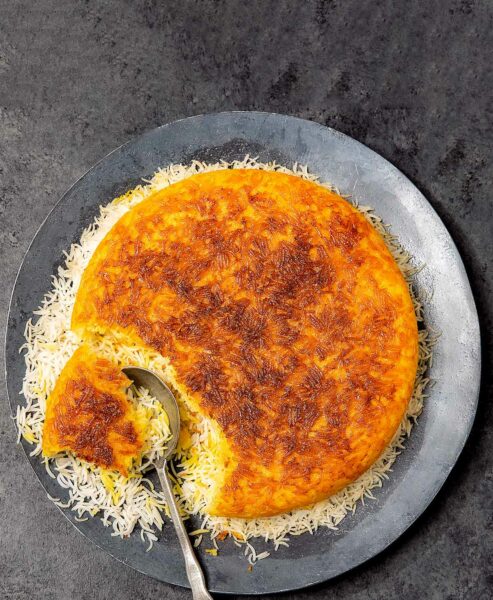
Tahdig
Ingredients
- 3 cups (21 oz) uncooked basmati rice, rinsed
- 3 tablespoons kosher salt
- 1/4 teaspoon saffron threads, finely ground with a mortar and pestle
- 1/4 cup boiling water
- 1 stick (4 oz) unsalted butter, melted and divided
- 1/2 cup plain full-fat Greek yogurt
- 1 large egg yolk
Instructions
- Place rice in a large bowl, add cold water to cover by 1-inch and 1 tablespoon of salt. Let soak for 1 hour, then drain in a colander.
- Meanwhile, in a medium bowl, combine saffron with boiling water, let sit until bright red, about 10 minutes. Whisk in 1 tablespoon of salt and 6 tablespoons of melted butter.
- In another medium bowl, whisk yogurt, egg yolk, and half of the saffron butter until smooth.
☞ TESTER TIP: Save yourself some dishes and whisk the yogurt and egg mixture in the rinsed-out bowl that the rice soaked in.
- Bring a large pot of water to a boil. Season with the remaining 1 tablespoon of salt. Add rice and boil until just tender but not fully cooked, about 5 minutes, then drain.
- Slick a shallow 10-inch (25 cm) non-stick pot with the remaining 2 tablespoons of melted butter.
- Gently stir 3 cups of the parboiled rice into the yogurt mixture, until rice is well coated. Spread coated rice over the bottom of the buttered pot and 2 inches (5 cm) up the sides. Top with remaining parboiled rice, drizzle remaining saffron butter over the top.
- Wrap a kitchen towel around the lid of the pot, covering the bottom, then place the lid on the pot. Place the pot over medium-high heat and cook until you begin to hear the rice sizzling loudly, 4 to 5 minutes.
☞ TESTER TIP: Don’t leave your tahdig unattended in case your kitchen towel begins to start burning.
- Reduce heat to low and cook until rice is golden brown, 25 to 30 minutes. The tahdig is ready when you begin to smell toasted rice–you can peek at the sides with a spatula to ensure the edges are golden.
- Remove from the heat and run a rubber spatula around the sides of the pot to ensure the rice doesn’t stick. Place a platter over the pot and carefully but quickly invert them together, remove pot so the crispy rice is on top, then serve.
Notes
Can I bake tahdig in the oven?
You’ll still get a flawless crust if you pivot fully to a dish called tahchin: a baked Persian casserole. Assemble it in a greased 9-by-13-inch glass baking dish, cover tightly with aluminum foil, and bake at 400°F (200°C) for about 2 hours. The best part is you can see the bottom to ensure it’s golden before flipping it out of the dish.
Explore More with AI
Nutrition
Nutrition information is automatically calculated, so should only be used as an approximation.
Recipe Testers’ Reviews
This is one of the most delicious and most impressive rice dishes I have ever made! I had Persian neighbours growing up and they introduced me to tahdig when I was a kid–I was obsessed and I have dreamt of making it ever since! This recipe is slightly different than what my neighbours used to make (their version used pita as the crust) but it is equally delicious!
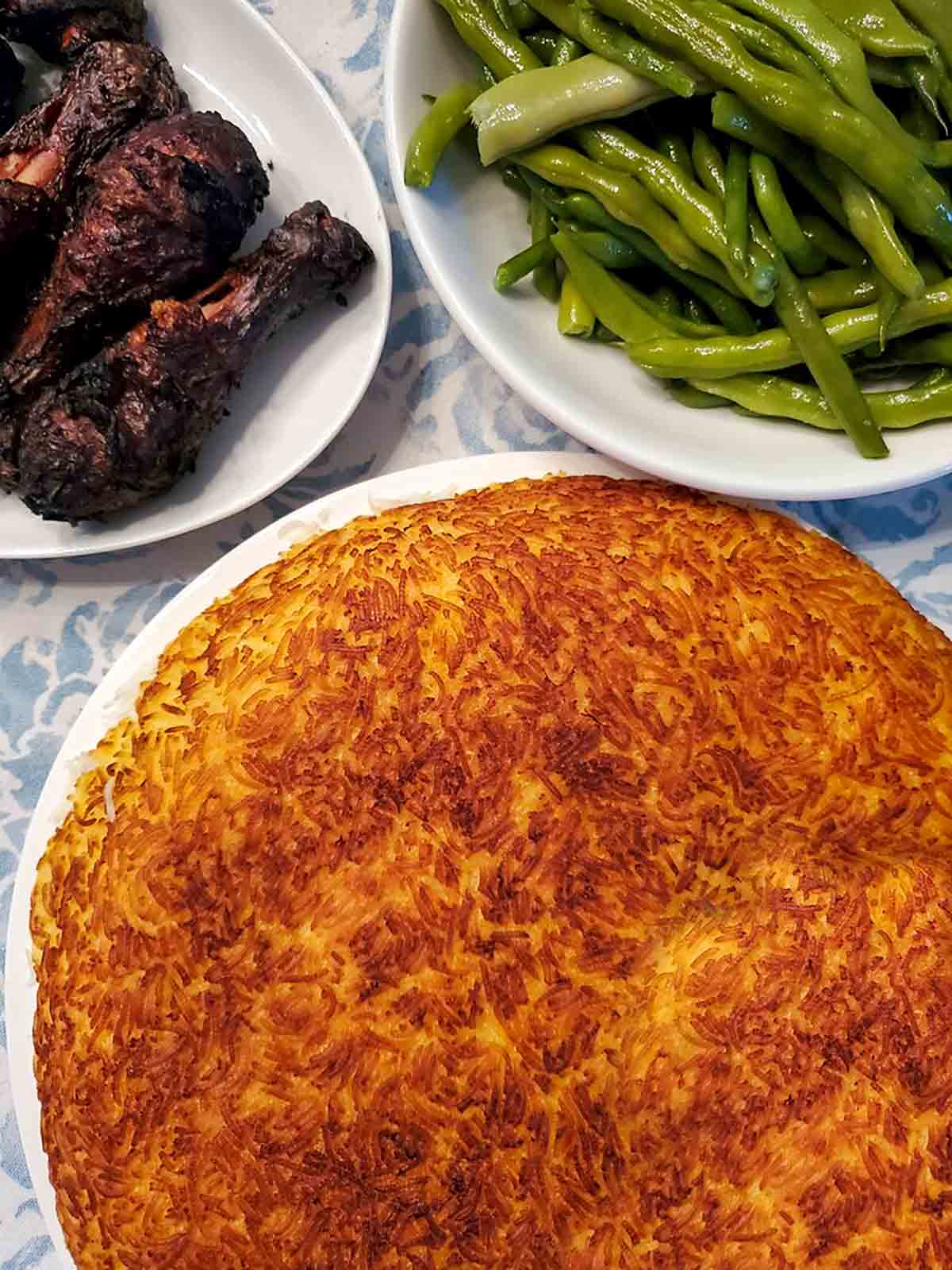
It is a little time-consuming, and definitely requires some bravery when it’s time to flip it out of the pan, but it is well worth it. The crispy rice crown is to die for and the fluffy, white and yellow speckled soft rice on top is just gorgeous and buttery. It makes a lot, so this is a good one when you want to impress your dinner guests, otherwise, I may suggest cutting the recipe in half.
Early in pre-pandemic 2020, I attended a Persian cooking class in LA where we made tahdig. Unfortunately, our group’s tahdig struggled on the dismount with a fractured (though no less delicious) crust that stuck to the pan and while I’ve wanted to try it again, I knew I’d need a different recipe.
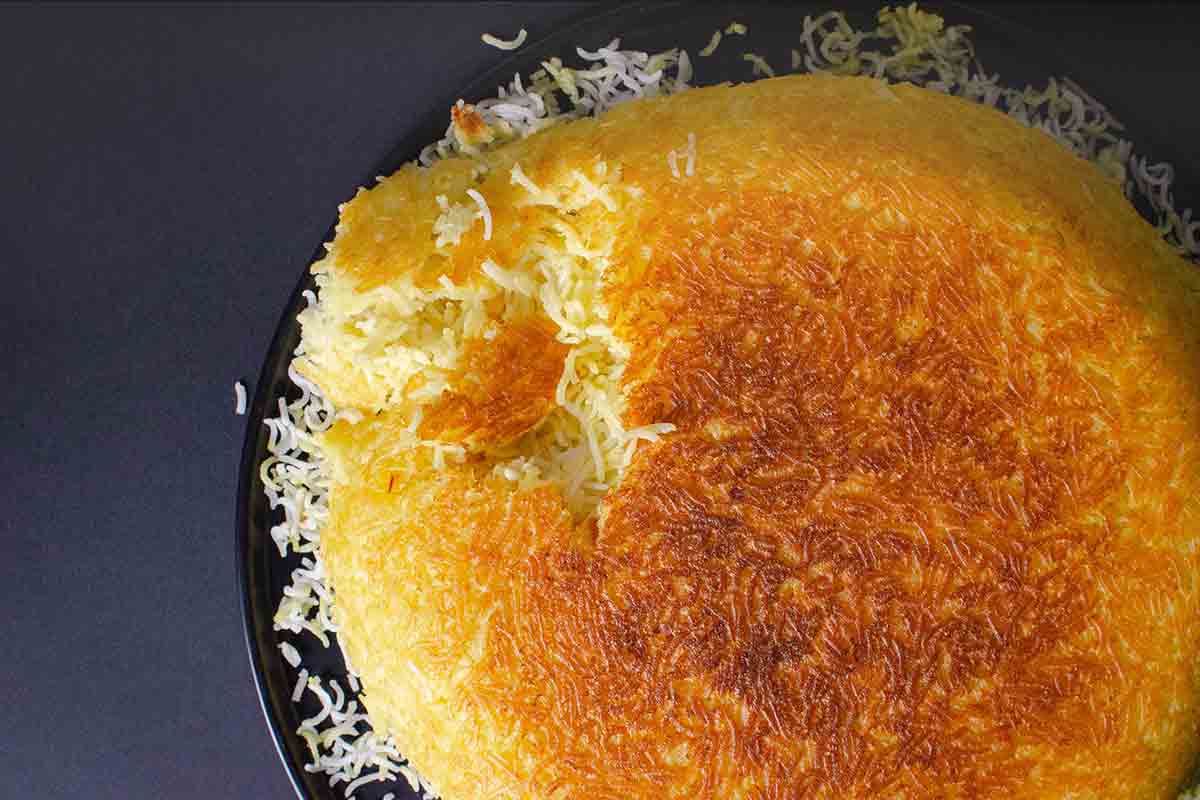
What you have here is I believe a perfect recipe that results in a gloriously crisp crust with a fragrant and well-seasoned pilaf layer underneath. The yogurt-yolk mixture is borrowed from the sturdier baked casserole version (Tachin) and serves as the insurance policy that holds the entire crust layer together. Salting the rice at each step (the soaking, the par-boiling, and the saffron-butter drizzle) guarantees there isn’t a bland bite in sight and you’ll want to shovel the entire thing into your mouth, going back for bite after bite of saffron-tinted serenity. Even more special is the tradition infused into the words and process, passed from the mother-in-law’s family to him, and now out to us, an entire virtual community of crispy-rice converts. It feels like that closely-guarded, special family recipe that would never be shared with outsiders, and I’m so thankful the author did.
I used my Breville Pizza Pan as my serving platter. Rice flipped out without sticking in a perfectly uniform shape. We served ours with Middle Eastern grilled chicken and a salad.
I just have to say that I appreciate tahdig so much! I love how the author points out the “crispy bits” obsession in many cultures, too, because it’s so true. I grew up nibbling pagao, the Puerto Rican version of tahdig. However, I believe the Persians take it to a whole other level by making tahdig, which is, in my opinion, not only a delicious way to cook rice but an art form, too.
The flipping it over and presenting the crispy tahdig as a centerpiece just makes me so happy. I’ve made tahdig once before and was excited to try this recipe out because as most cultural staples go, everyone has their own version and claims that to be the best way. I found this recipe to be solidly written and executed. I’m not a tahdig expert, but this technique worked very well for me.
I was so excited to see this recipe show up–I’ve always wanted to learn how to make tahdig and this seemed like a pretty easy version to execute.
And it was! Even the big flip at the end worked out pretty well. I didn’t have a perfect finished product but it still looked better than I thought possible. Crispy and golden on the top with a really tasty inside.
The only thing that I’d change is to use less rice and not really bother with the plain rice layer. I found it got kind of dry and took away from the incredibly flavoured interior and top rice. The yogurt, saffron, butter, and egg mixture is just SO good when cooked into the rice.
